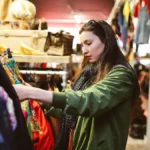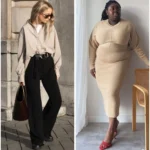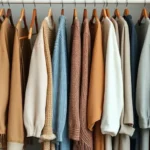Building an eco-friendly wardrobe is not just a trend; it’s a necessity for reducing our impact on the environment. An eco-friendly wardrobe focuses on minimizing waste, supporting sustainable brands, and choosing clothing that lasts.
Organizations like Greenpeace and designers such as Stella McCartney are leading the way, advocating for ethical fashion practices and encouraging consumers to make informed choices. The EU Eco-design Directive and movements like Fashion Revolution Week further emphasize the importance of sustainability in fashion.
In this guide, you’ll learn how to start your journey toward a greener closet with practical and effective steps, including actionable DIY projects and tips for sustainable shopping.
Why an Eco-Friendly Wardrobe Matters
An eco-friendly wardrobe matters because the fashion industry significantly impacts the environment.
Statistics from Greenpeace indicate that the global fashion industry is responsible for about 10% of annual carbon emissions.
Moreover, textile waste is a growing concern, with millions of tons ending up in landfills yearly. Choosing sustainable fashion helps reduce this environmental burden.
Laws like the EU Eco-design Directive encourage manufacturers to adopt greener practices, ensuring that products, including clothing, have a lower environmental footprint.
Supporting organizations such as Patagonia and Better Cotton Initiative (BCI) ensures you contribute to the movement for ethical and sustainable fashion. By making conscious decisions, you can significantly lower your carbon footprint and promote a healthier planet.
Understanding the Key Components of an Eco-Friendly Wardrobe
To build an eco-friendly wardrobe, focus on the following components:
- Sustainable Fabrics: Choose materials like organic cotton, linen, and Tencel, which require fewer resources and have a lower environmental impact. Look for certifications like GOTS to ensure fabric sustainability.
- Second-Hand Clothing: Opt for vintage shops or thrift stores to minimize waste and extend the lifecycle of garments. Buying second-hand not only reduces demand for new production but also supports a circular economy.
- Clothing Quality: Invest in high-quality pieces that last longer, reducing the need for frequent purchases and supporting a minimalist approach. High-quality clothing reduces waste and is ultimately more cost-effective in the long run.
Organizations like the Better Cotton Initiative (BCI) ensure that cotton production is more sustainable, helping you make responsible choices.
Brands like Patagonia promote the concept of durable clothing, encouraging less frequent consumption and ensuring ethical production practices.
Common Challenges in Building an Eco-Friendly Wardrobe
Building an eco-friendly wardrobe isn’t without challenges. Fast fashion is tempting due to its low cost, but it comes with high environmental and ethical costs.
Another challenge is the limited availability of truly sustainable options in some regions. Moreover, navigating claims like “eco-friendly” or “green” can be confusing due to greenwashing — when brands falsely advertise sustainability.
The Fashion Revolution Week movement aims to combat this by promoting transparency within the industry, ensuring consumers have access to accurate information.
How to Overcome Challenges in Building an Eco-Friendly Wardrobe
- Research Brands: Investigate a brand’s sustainability practices before purchasing. Look for certifications like GOTS (Global Organic Textile Standard) and BCI to verify claims. Reliable certifications help you distinguish between genuine sustainability efforts and greenwashing.
- Buy Less, Choose Well: Adopt a minimalist mindset by focusing on fewer but higher-quality items that can be worn for years. Reducing overall consumption is key to an eco-friendly wardrobe.
- Support Sustainable Brands: Buy from brands like Patagonia or Stella McCartney, which are committed to ethical and sustainable practices. These brands set industry standards for transparency and sustainability.
- Upcycle Clothing: Transform old garments into new ones to extend their life and reduce waste. For example, convert an old pair of jeans into a stylish tote bag or cushion covers. Upcycling helps foster creativity while promoting sustainable consumption.
- Educate Yourself: Follow influencers like Livia Firth, who advocate for sustainable fashion and educate consumers about ethical practices. Knowledge is power when making sustainable choices.
- Join the Movement: Participate in initiatives like Fashion Revolution Week to learn more about sustainable clothing choices and encourage brands to adopt transparent practices. Get involved in community events to build awareness.
- Avoid Greenwashing: Look for third-party certifications like GOTS or OEKO-TEX to confirm a brand’s eco-credentials and avoid misleading claims. Trusted certifications are a clear indicator of a brand’s commitment to sustainability.
Real-World Examples and Case Studies of Eco-Friendly Fashion Success
- Patagonia has implemented the Worn Wear initiative, encouraging customers to trade in old items for discounts or store credit, promoting a circular economy and extending the lifecycle of their products.
- H&M’s Garment Collection Initiative allows customers to recycle their old clothes in exchange for discounts, aiming to reduce textile waste and promote recycling. Despite being a fast fashion brand, H&M is working towards improving its sustainability practices by incorporating recycled materials in their production.
- Fashion Revolution Week has raised awareness about the importance of transparency in fashion, pushing brands to disclose their environmental impact and improve sustainability practices. This movement has influenced numerous companies to reassess their policies.
DIY Projects for an Eco-Friendly Wardrobe
Creating an eco-friendly wardrobe can also involve fun DIY projects that help you upcycle and repurpose old clothes:
- Turn Old Jeans into a Tote Bag: Use an old pair of jeans to create a durable tote bag. This project is simple and helps reduce textile waste.
- Revamp T-Shirts: Cut and redesign old t-shirts to create trendy crop tops or reusable shopping bags.
- Natural Dyeing: Use natural ingredients like turmeric, beetroot, or coffee to dye old clothing, giving them a new look without harmful chemicals.
These DIY projects not only make your wardrobe more sustainable but also allow you to personalize your style.
Frequently Asked Questions About Eco-Friendly Wardrobes
- What is an eco-friendly wardrobe?
An eco-friendly wardrobe consists of clothing made from sustainable materials, bought with the goal of reducing environmental harm and promoting ethical practices. It prioritizes quality over quantity and supports brands committed to sustainability. - How can I start building an eco-friendly wardrobe?
Start by purchasing quality over quantity, choosing sustainable fabrics, supporting ethical brands, and buying second-hand where possible. These steps help you reduce your environmental footprint. - What are the common challenges in creating a sustainable wardrobe?
Challenges include the high cost of sustainable brands, fast fashion’s appeal, limited access to sustainable options, and difficulty in verifying a brand’s sustainability claims. However, with research and mindful consumption, these challenges can be overcome. - How can I repurpose old clothing items?
You can repurpose old clothing by upcycling them into new items, such as transforming jeans into tote bags or using natural dyes to refresh old garments.
Key Takeaways for Building an Eco-Friendly Wardrobe
- Choose Sustainable Fabrics: Opt for materials like organic cotton, linen, and Tencel, which have a lower environmental footprint. Certifications like GOTS help ensure sustainability.
- Support Ethical Brands: Brands like Patagonia and Stella McCartney are at the forefront of sustainable fashion and ethical practices. Supporting these brands means contributing to a positive environmental impact.
- Educate Yourself: Understand the impact of fast fashion and avoid brands involved in greenwashing by verifying their claims. The more informed you are, the better decisions you make.
- Participate in Initiatives: Join events like Fashion Revolution Week to stay informed and be part of the movement for change. Engagement at the community level can drive industry-wide improvements.
- Get Creative with DIY Projects: Upcycle your old clothes into something new and unique. This is a fun way to reduce waste and add personal flair to your wardrobe.
Building an eco-friendly wardrobe is a meaningful way to reduce your impact on the environment.
By choosing high-quality, sustainable clothing and supporting brands that prioritize ethical practices, you can contribute to a more sustainable future.
Take action today by exploring sustainable fashion brands, making conscious shopping decisions, and participating in initiatives like Fashion Revolution Week.
Remember, every small step towards sustainability creates a collective impact. Start your journey by trying out some of the DIY projects mentioned here to personalize your sustainable wardrobe. [End of Article]
Ready to make a difference? Start building your eco-friendly wardrobe today by researching sustainable brands, making conscious shopping decisions, and getting involved in community sustainability efforts.







